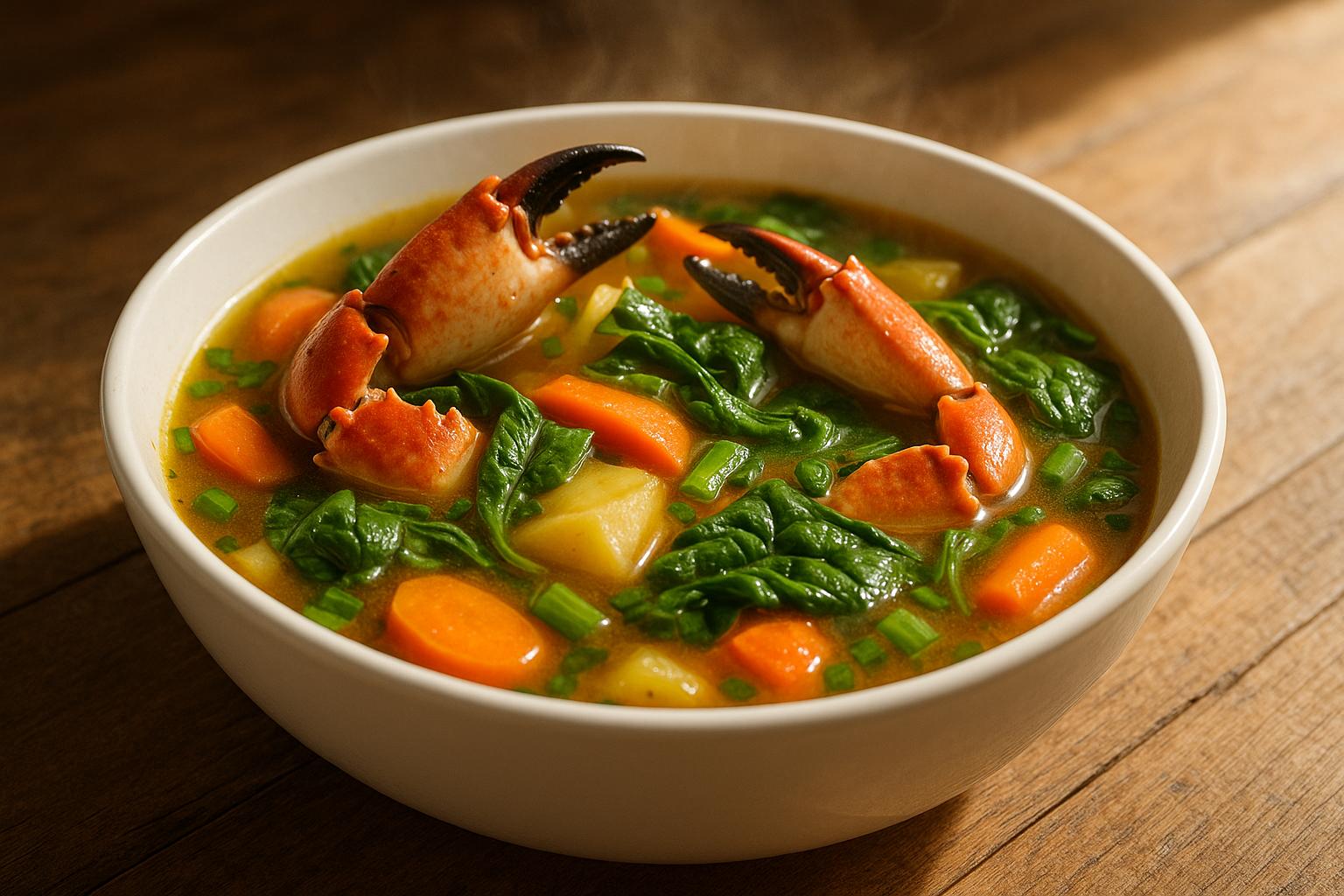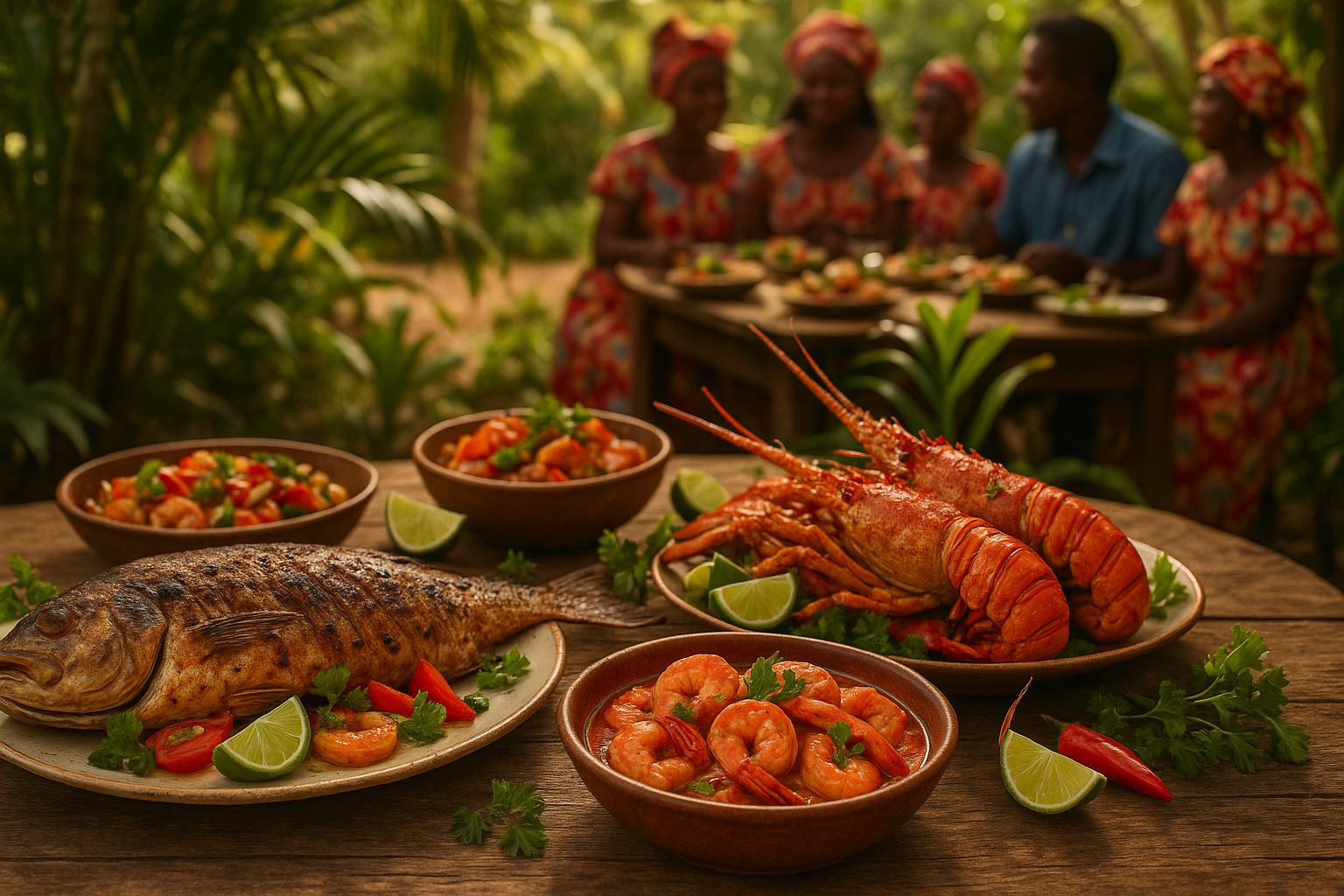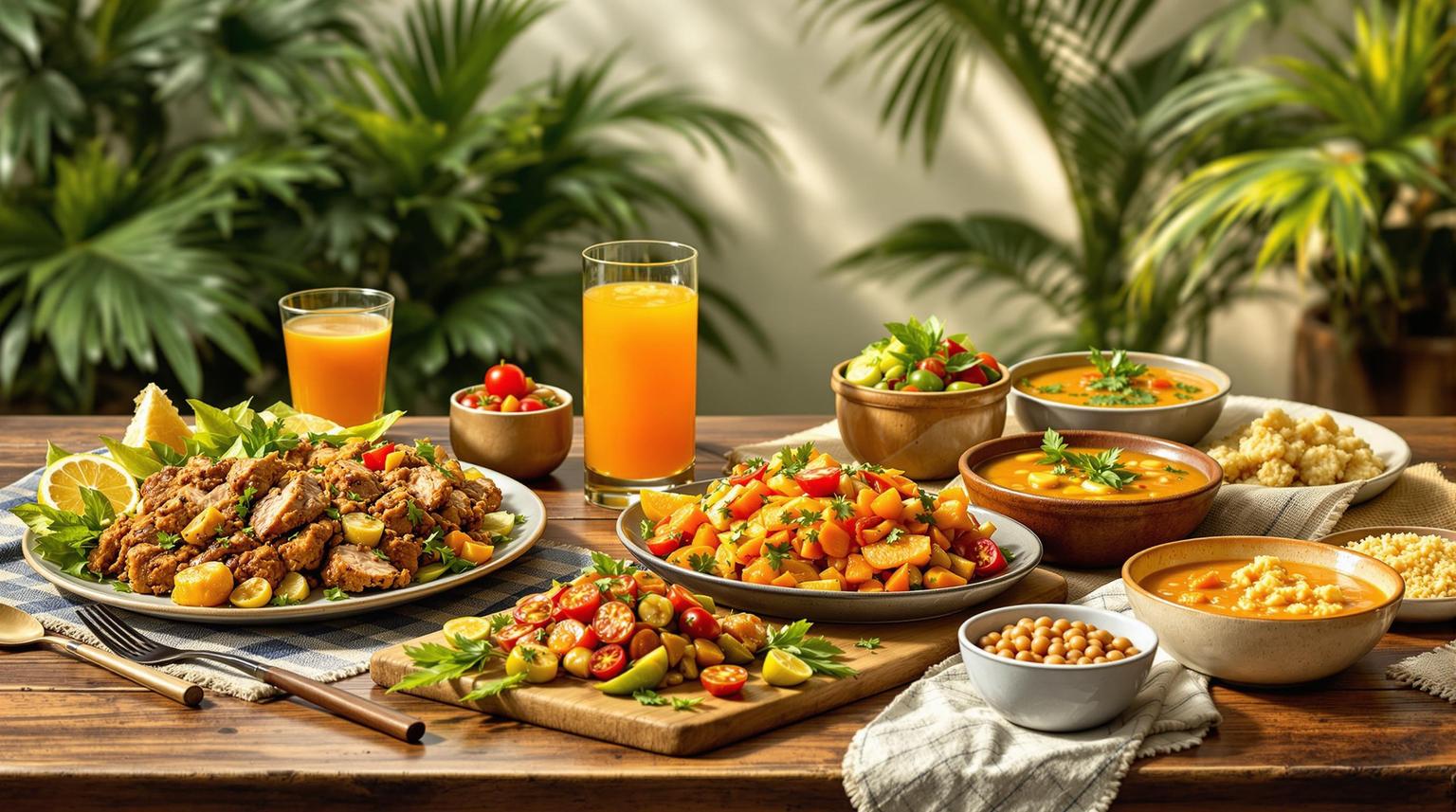Haitian cuisine is a rich blend of history, flavors, and personal stories. This article explores how chefs are using their signature dishes to share Haiti's culinary heritage and challenge stereotypes. Key highlights include:
- Signature Dishes as Personal Stories: Chefs like Widza Gustin and Nadege Fleurimond infuse family traditions into their creations, such as Diri Djon Djon with Shrimp and Creole Braised Vegetables.
- Historical Significance: Iconic dishes like Soup Joumou and Griyo carry deep historical meaning, symbolizing resilience and freedom.
- Global Recognition: Events like Haitian Restaurant Week and international festivals are helping chefs showcase Haitian food worldwide, from Paris to Miami.
- Chefs' Journeys: Haitian chefs, including Cynthia Verna and Gregory Gourdet, share personal stories of overcoming challenges and finding inspiration in their roots.
- Cooking Techniques and Ingredients: Key elements like epis seasoning, black mushrooms, and marination define Haitian cooking, creating bold and layered flavors.
Platforms like HaitianFoods.org play a key role in connecting diners with Haitian restaurants and supporting chefs, ensuring the preservation and celebration of Haiti's culinary traditions.
Gregory Gourdet Make His Famous Haitian Patties | Top Chef: The Dish With Kish (S22 E3) | Bravo

Featured Haitian Chefs
Haitian chefs masterfully weave tradition with modern techniques, each offering a personal touch to the rich tapestry of Haitian cuisine. By drawing from their heritage, these chefs craft dishes that honor their roots while exploring new culinary horizons. Their journeys celebrate tradition and pave the way for the future of Haitian cooking.
Chef Backgrounds and Early Influences
Chef Alan Lemaire began his culinary journey in 2003 while attending culinary college in Miami, sharpening his skills in catering and restaurant kitchens [4]. His passion for cooking is deeply rooted in family traditions passed down from his mother and grandmother [4].
"My inspiration comes from food mostly. I simply love food and the pure form of the art on its own", says Chef Lemaire [4].
But his path to becoming a chef wasn’t easy. He faced skepticism, even from his family:
"When I first decided to pursue my education in culinary arts, everyone was a little skeptical - especially my family... It was a big issue that I personally had to deal with", he recalls [4].
Chef Cynthia "Thia" Verna discovered her love for cooking at just 17, working in her mother’s restaurant in Haiti [5][7]. Mentored by the renowned Haitian chef Reginald Koury, she honed her skills early on [5][7]. Later, she graduated cum laude from Le Cordon Bleu Culinary Institute in Miami, further solidifying her culinary expertise [7].
Chef Gregory Gourdet found inspiration in his mother’s cooking. Initially planning a medical career, he shifted gears to attend the Culinary Institute of America [9]. His connection to Haitian cuisine grew stronger over time:
"I always loved watching my mom cook... I grew up in a Haitian household, and my mom was an amazing caretaker. Even though she had two jobs, there was always food on the table!" [9]
Chef Nadege Fleurimond learned to cook from her father, creating cherished memories of preparing meals and drinks for him and his friends [8]. Her move to the United States deepened her connection to cooking:
"I had left everything behind, so in the early days I was so homesick I hardly ate. It wasn’t until my dad started showing me how to cook Haitian food that I began connecting to being in the U.S. It didn’t feel so foreign anymore once I started cooking the food that reminded me of home. As I look back now, I see how my childhood was the perfect set up for my career, yet I never knew it", she reflects [8].
Chef Albertho Appolon discovered cooking during high school as a way to express love and care for others during tough times [6]. Unlike many chefs who plan their careers, cooking became his unique form of self-expression [6].
These early experiences shaped the signature dishes and culinary identities of these chefs, reflecting their personal and cultural roots.
Career Achievements in Haitian Cuisine
Grounded in tradition, these chefs have reached impressive milestones, showcasing Haitian cuisine to the world.
Chef Lemaire’s career took a pivotal turn in 2012 when he decided to focus on building his own culinary brand:
"In 2012, I focused on building my unique culinary identity", he explains [4].
Chef Thia has earned acclaim on both national and international levels. In 2017, she became the first woman to win the People’s Choice Award at the Embassy Chef Challenge in Washington, D.C., competing against chefs from 30 countries [7]. This achievement was so celebrated that North Miami declared November 18, 2017, as "Cynthia Verna Day" [7].
Her global influence is equally notable. Chef Thia has represented Haitian cuisine at events worldwide, including teaching over 80 students at Taiwan’s top university [7]. She has also showcased her culinary expertise in Italy and other international venues, serving as an ambassador for Haitian food [7].
Beyond the kitchen, Chef Thia has expanded her reach through media and publishing. She co-hosts the Caribbean cooking series Taste the Islands and co-authored the bestselling cookbook 50 Favorite Haitian Recipes [7]. Her television appearances include No Passport Required with Chef Marcus Samuelsson and Can’t Cook with Ludacris on the Food Network [7].
Chef Gourdet’s crowning achievement is his restaurant, Kann, which represents a deeply personal project:
"Kann came out of not wanting to work for other people anymore and wanting more control. Just kind of wanting to do my own thing. After working in restaurants that featured so many other types of cuisines, I felt I wasn’t spending enough time learning about my own culture", he shares [9].
These chefs have elevated Haitian cuisine to new heights, blending personal heritage with professional expertise. Their work not only celebrates their roots but also introduces the richness of Haitian flavors to a global audience, inspiring others through their culinary journeys.
Signature Haitian Dishes
Every signature dish tells a story - of personal journeys, family traditions, and a deep sense of pride. Haitian cuisine is no different, offering a vibrant showcase of culinary artistry and cultural heritage.
Stories Behind the Dishes
Take Chef Widza Gustin's Diri Djon Djon with Shrimp, for example. This dish is rooted in her childhood memories and family traditions. Chef Gustin has reimagined the classic black mushroom rice by adding jumbo shrimp, a nod to her mother’s practice of enriching the dish with dried shrimp soaked in the cooking water [1]. It’s her way of honoring her roots while adding her own creative spin.
"When we were young and would go to Haiti, my mom and my aunt would be the two people who would pretty much feed the town", Chef Gustin shares [1].
Her journey into the culinary world wasn’t just about nostalgia; it was about representation.
"I really wanted to get into the food industry to amplify Haitian voices and Haitian food. A lot of people didn't really know about Haitian cuisine, and I feel like nowadays it's definitely something that a lot of people are opening their eyes to", she explains [1].
Chef Vanessa Cantave draws inspiration from Northern Haiti’s cashew groves with her Haitian Cashew Chicken. Lime-washed chicken thighs are simmered with epis, onions, tomatoes, and peppers, then finished with buttery cashews and served over jasmine rice [10]. This dish beautifully reflects the flavors of a specific Haitian region, showcasing ingredients that thrive in the local landscape.
Meanwhile, Chef Nahika Hillery brings a modern, plant-based twist to traditional flavors with her Creole Braised Vegetables over Haitian Black Rice. Her dish pairs braised squash, eggplant, cabbage, and peppers with sweet fried plantains and savory black rice [10]. It’s a perfect example of how Haitian cuisine can evolve while staying true to its roots.
Chef Stephan Berrouet Durand emphasizes the universal language of food:
"Food is universal - it brings people together and communicates the essence of our culture by sharing a piece of Haiti with every diner", he reflects [2].
For Chef Albertho Appolon, it’s about redefining perceptions of Haitian cuisine by combining bold flavors with elegant presentation:
"I want to showcase that you can create beautiful art with food and flavors that are unique to Haiti. Most people don't think of fine dining when they think of Haitian food - but I want to change that! I want people to feel proud to go on a date at a Haitian restaurant", he says [6].
Each of these chefs uses their craft to tell a story, connecting diners to Haiti’s rich culinary landscape through their passion and creativity.
Key Ingredients and Cooking Methods
Haitian cuisine comes alive through its bold ingredients and time-honored techniques. At the heart of it all is epis, a vibrant seasoning blend of garlic, bell peppers, scallions, parsley, thyme, and Scotch bonnet peppers, processed with oil or vinegar [10]. It’s the backbone of countless dishes, infusing them with depth and flavor.
One of Haiti’s standout ingredients is the black mushroom used in Diri Djon Djon. These mushrooms are simmered to create a dark, savory broth that gives the rice its earthy, umami-rich flavor. Often paired with lima beans, shrimp, or seasoned vegetables, the dish is elevated with thyme, cloves, and epis [10].
Another classic is Griyo, a dish that starts with pork shoulder marinated in sour orange juice and epis. The meat is boiled, then fried to achieve a tender interior and crispy exterior. It’s often served with pikliz, a tangy vinegar-based slaw made with cabbage and carrots, which cuts through the richness of the pork [10].
Haitian chefs rely heavily on slow braising and stewing to build flavor. Dishes like legim (vegetable stew) and kabrit nan sos (goat in sauce) start with proteins marinated in citrus juice and epis, then cooked slowly to achieve tender, flavorful results [10].
Marination is another cornerstone of Haitian cooking. Proteins are soaked in blends of sour orange juice, lime juice, or vinegar with epis, allowing the flavors to penetrate deeply while tenderizing the meat or seafood [10]. This process ensures that every bite bursts with the signature Haitian flavor.
Texture also plays a key role. Haitian dishes often balance crispy and soft elements - like fried plantains paired with velvety stews, or the crunch of pikliz alongside rich, slow-cooked meats [10]. It’s this interplay of textures that creates such a dynamic dining experience.
As Chef Appolon puts it:
"Haitian food is much more about the flavor than the presentation. There is a lot of Caribbean influence and Creole spices. It's more about big, bold flavors and dining with a big group of people rather than making the food look pretty on the plate", he notes [6].
These dishes are more than meals - they’re cultural expressions, inviting the world to experience Haiti’s culinary soul through the stories and dedication of its chefs.
sbb-itb-80c33ff
Haitian Dishes at Culinary Events
Culinary events offer Haitian chefs a chance to share their heritage and challenge stereotypes about Haiti. These gatherings provide a platform to introduce bold, authentic flavors to a variety of audiences, fostering connections through food. From crafting personal signature dishes to presenting them on international stages, Haitian chefs continue to expand their culinary influence. These events not only highlight the richness of Haitian flavors but also spark conversations about the country's vibrant food traditions.
Presenting Haitian Cuisine Worldwide
Haitian chefs are making waves at global culinary events, showcasing their signature dishes and putting Haitian cuisine on the map. Chef Alain Lemaire, for example, has participated in prominent festivals like the South Beach Wine & Food Festival, Charleston Wine & Food Festival, and Grace Jamaican Jerk Festival [11].
In May 2016, Chef Stephan Berrouet Durand represented Haiti at the 8th annual Embassy Chef Challenge in Washington, D.C. His dish, "Calalou Gumbo", featured oxtail and crispy pork belly served with black mushroom rice (diri djondjon) and was paired with a "Ti-Punch" cocktail [15]. Events like these highlight how Haitian chefs use their culinary talents to celebrate and share the country's rich traditions.
Haitian cuisine has also gained recognition through initiatives like Haitian Restaurant Week, which has expanded internationally to cities such as Paris and London, offering unique culinary experiences [3]. Similarly, the Taste of Haiti event, hosted by the Haitian Culinary Alliance at the Museum of Contemporary Art in North Miami, Florida, attracted over 12,000 attendees in May 2016 [14].
Chef Tina, a Haitian migrant running a pop-up in Greenfield, Massachusetts, brings traditional dishes like soup joumou, legume, and diri ak pwa to these events. Her work not only preserves the essence of Haitian flavors but also supports her local community [12].
"When they eat Haitian food, they will see the difference. Because when I make Haitian food, I feel home. I put myself entirely in it", Chef Tina shares [12].
While these events celebrate Haitian culinary artistry, they also come with their own set of challenges and achievements.
Challenges and Successes in Food Events
Bringing Haitian cuisine to international audiences comes with both hurdles and rewards. One major challenge is overcoming stereotypes often associated with Haiti, such as those tied to poverty or natural disasters, and instead presenting the country's refined culinary heritage [15]. Chefs must also find ways to balance traditional flavors with the tastes of broader audiences [11][12]. Preparing large-scale dishes without sacrificing the depth and authenticity of Haitian flavors is another significant task.
Despite these challenges, these events have achieved notable successes. They serve as powerful platforms for cultural exchange while also providing economic opportunities for Haitian chefs and restaurateurs. As Chef Jonathan Woodbury eloquently puts it:
"Dining should be more than nourishment - it should be a cultural celebration" [13].
Through these events, Haitian chefs not only preserve their traditions but also connect communities and share their stories, proving that food truly is a universal language.
How HaitianFoods.org Supports Haitian Cuisine

HaitianFoods.org plays a key role in celebrating and promoting Haitian cuisine by connecting food enthusiasts with authentic dining experiences and supporting the chefs and restaurateurs who bring these flavors to life. The platform acts as a bridge, ensuring the rich culinary traditions of Haiti are both preserved and shared with a wider audience.
Connecting Diners to Haitian Restaurants
HaitianFoods.org operates as a go-to directory for anyone seeking authentic Haitian dining. Its "Best Haitian Restaurants Near You" feature uses location-based search to help users find nearby spots serving traditional Haitian dishes. For instance, in South Florida - where Haitian cuisine thrives - the platform highlights standout restaurants such as:
- Cecibon Restaurant: With locations in Miami and Fort Lauderdale, Cecibon offers Haitian-Caribbean classics like griot, tassot, and legume.
- Le Jardin Haitian Restaurant: Situated in Miami's Little River, this spot serves up favorites like griot and legume, complemented by late-night hours and delivery or pickup options.
- Sak Pase Restaurant: Known for its flavorful takes on griot, legim, and tassot, this Miami restaurant has earned its reputation for authentic Haitian cuisine [16].
To deepen the experience, HaitianFoods.org also features a blog filled with recipes, cooking tips, and cultural stories, giving diners a closer connection to the traditions behind each dish [16].
Supporting Chefs and Restaurant Owners
For Haitian chefs and restaurant owners, HaitianFoods.org offers vital exposure. The platform allows businesses to submit their information for listing, helping them reach a broader audience. Each listing highlights the unique dishes and specialties of the establishment, showcasing the authenticity and artistry of Haitian cuisine.
Beyond individual listings, HaitianFoods.org strengthens the entire culinary community by boosting visibility for Haitian-owned restaurants. This increased exposure can lead to more foot traffic, higher online orders, and overall growth for these businesses. Additionally, the platform’s blog preserves Haitian culinary heritage by documenting traditional recipes, techniques, and stories. By providing this support, HaitianFoods.org ensures that the vibrant flavors and traditions of Haitian cuisine continue to thrive and inspire future generations of food lovers.
Conclusion
Haitian chefs are preserving their heritage and sharing their stories through the flavors of their signature dishes. By reimagining traditional recipes, they create connections to Haiti’s rich culture and foster a sense of community. This discussion has highlighted just how impactful Haitian culinary traditions can be.
Chef Gustin’s approach showcases how serving authentic Haitian cuisine can spark meaningful conversations and challenge misconceptions about Haiti and its people. As Stephan Berrouet Durand aptly points out, food has the power to create deep emotional bonds when people experience genuine Haitian flavors.
"I get to share my cuisine with the world. To have somebody come and tell me, 'Oh, I've been to Haiti. I remember this,' that touches your soul. That touches right into your soul because you know that you've not only shared a piece of Haiti with someone, you have people who have been to Haiti and recall their experience as so positive." [2]
Platforms like HaitianFoods.org play a crucial role in elevating this mission. They connect food enthusiasts with authentic Haitian restaurants and give restaurant owners a platform to showcase their work on a global stage.
This movement is also dismantling long-standing stereotypes about Haitian food in the United States. These chefs are rewriting the narrative, ensuring that Haitian cuisine receives the recognition it deserves. Their dedication to authentic flavors and techniques is paving the way for future generations. As culinary student Peraldine Alceguerre passionately states:
"This is my country's culture and I want to show it off." [17]
Through their dishes and the support of platforms that amplify their voices, Haitian chefs are reshaping how the world views Haiti - one plate at a time.
FAQs
How do Haitian chefs bring their heritage and personal stories into their signature dishes?
Haitian chefs bring their dishes to life with bold flavors and a deep respect for Haiti's rich history. The country's culinary traditions are a vibrant mix of African, French, Taíno, and Spanish influences, creating a unique blend that tells a story with every meal. Take soup joumou, for example - a beloved dish served on New Year's Day. It’s more than just a pumpkin soup; it’s a powerful symbol of freedom, celebrating Haiti's independence and resilience.
Through the use of aromatic spices, time-honored cooking techniques, and ingredients inspired by the island, chefs not only honor their heritage but also invite others to experience Haiti's spirit and history. Each dish becomes a reflection of personal stories and a connection to the island’s culinary roots, ensuring every bite is rich with meaning and unforgettable.
What challenges do Haitian chefs face when introducing their cuisine to international audiences?
Haitian chefs encounter a unique set of challenges, including the struggle to achieve broader recognition for their cuisine and addressing misconceptions about their food. Though Haitian dishes are packed with rich flavors and steeped in history, they often don’t get the spotlight they deserve on the global stage, which can limit opportunities for chefs to gain visibility.
On top of that, bringing authentic Haitian dishes to life can be tricky. Sourcing traditional ingredients isn’t always straightforward, and competing in major culinary events often comes with its own set of hurdles. Yet, despite these barriers, Haitian chefs remain deeply committed to sharing their heritage with the world. They approach these challenges with determination and creativity, working tirelessly to bring the vibrant essence of Haitian cuisine to a global audience.
How does HaitianFoods.org help preserve and promote Haitian culinary traditions?
HaitianFoods.org is dedicated to keeping the heart of Haitian culinary traditions alive. By showcasing authentic recipes, sharing stories that reflect Haiti's rich history, and shining a spotlight on the distinct flavors of its cuisine, the platform creates a space where food enthusiasts can truly connect with Haitian culture.
Beyond recipes, it acts as a bridge between people and Haitian restaurants or events, offering opportunities to dive into the vibrant world of Haitian cooking. It's not just about savoring the food - it's about understanding the heritage behind it.
The platform also serves as a learning hub, inspiring families and communities to preserve traditional recipes and cooking methods. By engaging both the Haitian diaspora and global food lovers, HaitianFoods.org ensures these treasured culinary traditions remain alive and celebrated for generations to come.


